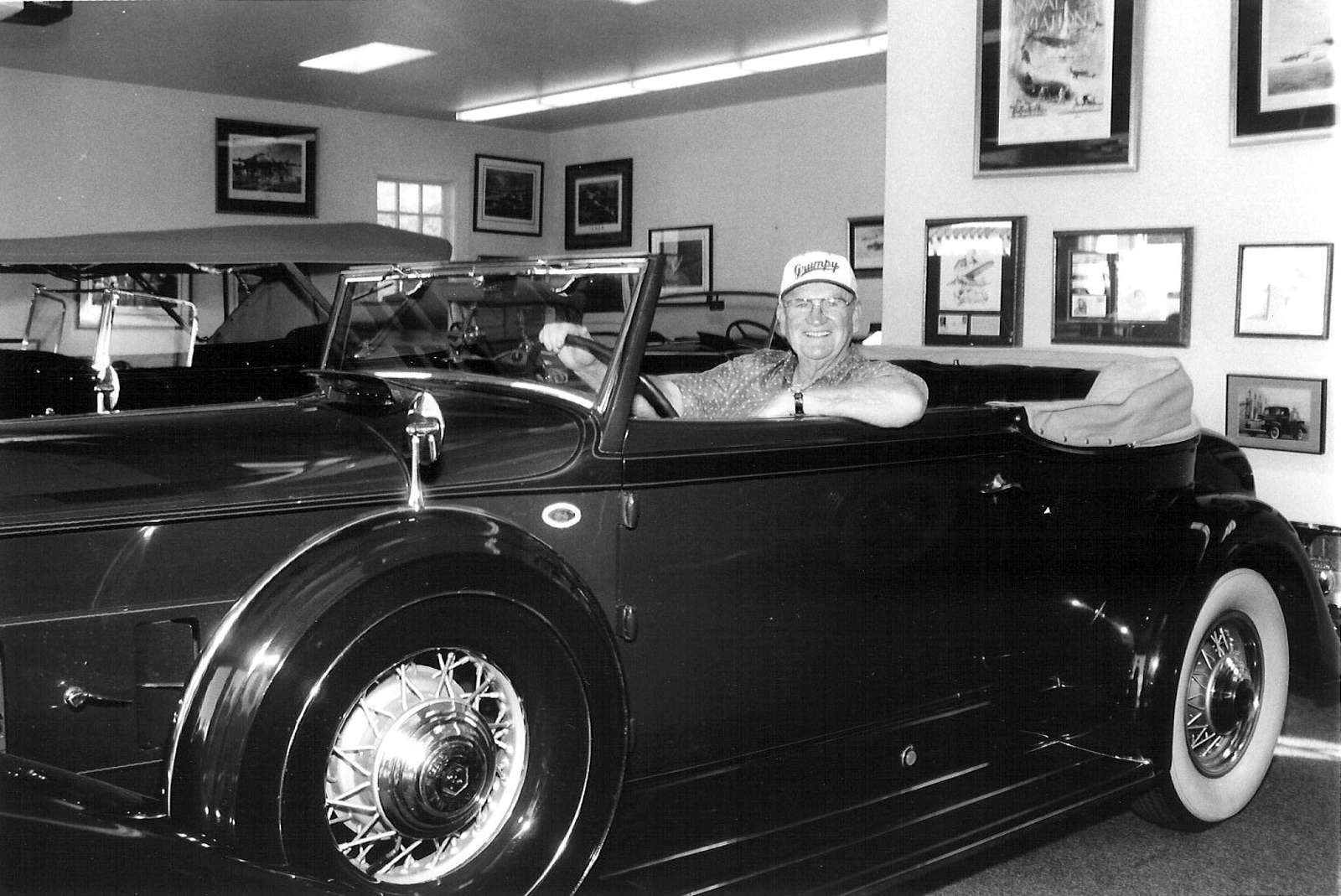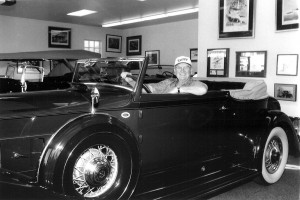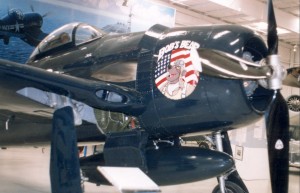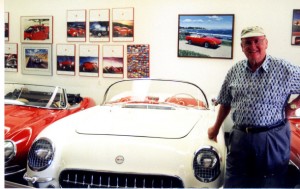|
By Clayton Moore
No one loved aviation more than Bob Pond, who died at Desert Regional Medical Center, after suffering a brain hemorrhage, on Dec. 21, 2007. In an earlier interview with Airport Journals, Pond, the founder of the Palm Springs Air Museum in California, remembered his indoctrination into “real flying.” “I got interested in aviation when I was about 10 years old,” he recalled. “As kids do, I started making models. About that time, my dad took me to Chicago and gave me my first plane ride.” He vividly remembers that ride at the rough-hewn airport that would become Meigs Field. “In the process of enjoying the ride in the copilot’s seat, I stuck my arm out the window and realized you could lose an arm that way,” he said. That didn’t scare him away. “Flying has been such an important part of my life ever since,” he said. Pond was born in Edina, Minn., on May 23, 1924. Because of his love of aviation, he spent hours hanging around the airport in his youth. He graduated from Shattuck Military School in Faribault, Minn., in 1942, just as World War II was in full swing. Over his parents’ protests, he signed up for the Navy Air Corps program. “It wasn’t easy,” he recalled. “I had to threaten that I was going to join the Army; it was a bit of a devious way for me to sign up for the Navy Air Corps. Several of my friends had joined the Navy, and it seemed like the right thing to do. It was at the very beginning of when they would let 18-year-olds join the Navy Air Corps. I got in just under the wire, as did George Bush (Sr.). He’s 38 days younger, but he got into the training about six months earlier than I did. I guess he didn’t have trouble with his parents.” |
Pond entered the service on Dec. 7, 1942. In the naval aviation program, he learning about engines, aircraft, navigation, and finally, flying. He trained at Albert Lee, Minn., in a J-3 Piper Cub identical to one in the Palm Springs Air Museum today. From there, he went on to survival training in Iowa and to Corpus Christi, Texas, where he learned to fly multi-engine aircraft and earned his Navy wings. Additional training took place in Ottumwa, Iowa.
By 1944, Ensign Pond was stationed in Florida, where he learned carrier tactics. He flew a variety of multi-engine military aircraft ranging from the PBY4, a Navy version of the B-24 bomber, to the PBY Catalina and the JM1 Navy transport.
Advance Machine

One of 12 B-17s still flying, Miss Angela was used as a fire bomber during the 1960s. Bob Pond restored the plane, gave it the marks of the 34th Bomber Group, 8th Air Force, and named it after his granddaughter.
Pond was scheduled to head out to Honolulu on July 4, 1945, but the war had ended by then. He knew what he wanted to do, but life took him down a different path.
“People coming out of the Navy didn’t know anything but going back to school or getting flying jobs,” he said. “I didn’t particularly want to be a barnstormer. Most of us were interested in getting into commercial aviation; the airplanes that the airlines were just beginning to buy were wonderful. But I managed to talk myself out of it. I enrolled in the University of Minnesota, but all the time I had my eye out for anything that was connected to aviation.”
Pond graduated in 1948 with a bachelor’s degree in business administration. He then joined the family business, started by his grandfather, Merritt Pond, in 1910, and headed later by Robert Pond’s father, Harold Pond. Advance Machine Shop, located on Southeast Fourth Street in Minneapolis, initially repaired equipment for the grain milling industry.
Before Pond joined the company as its bookkeeper, Advance Machine had seen several changes. In 1922, the company began repairing terrazzo grinding machines for the terrazzo floor industry. Two years later, Advance introduced its first product, a terrazzo grinder, and demonstrated it to contractors throughout the United States. By the late 1920s, the company had begun making floor scrubbers and polishers. In the 1930s, Advance began making Lowboy floor machines, named because of the ability to reach under desks and furniture. By then, the company’s terrazzo machines were the industry standard.
Advance helped the American cause in World War II by making parts for B-17 bombsights. Shortly after Pond joined the company, Advance introduced the Speedboy Deluxe floor machine, which featured a major engineering breakthrough in floor machine design: a flexible gear drive. By the mid-1950s, company products included two floor scrubbers and a wet/dry tank vacuum.
In late 1955, Advance Machine moved into a 10,000-square-foot building on Washington Avenue in Minneapolis, but retained the company’s original location. By 1958, the factory employed 40 people. Needing room to grow, the company bought a 105,000-square-foot building, located in Spring Park, not far from Minneapolis. That same year, Advance introduced the first Convertamatic automatic scrubber, which converted quickly from an automatic floor scrubber to a dry floor polisher and vacuum.
Pond moved into sales and management, before becoming CEO in 1962. He eventually built the company into one of the world’s largest manufacturers of floor-cleaning equipment.
A use for aviation
After graduating from the University of Minnesota, Pond gave in to the urge to buy a Cessna 180. He pointed out that aviation had a lot to do with the company’s success.
“We incorporated aviation into our business very early, but it was almost over my dad’s dead body,” Pond laughed. “He wasn’t frightened of airplanes, because he did use them, but he didn’t like his son flying them. He wanted me in that business, and not, as he would say, ‘getting killed out there, flying those damned airplanes.'”
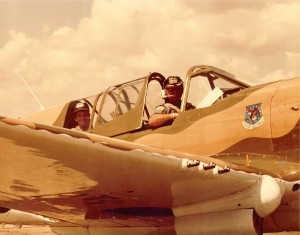
Bob Pond began his vintage aircraft collection in 1970 with this Curtiss P-40 Warhawk and a P-51 Mustang.
A heavy proponent of technological innovation and inventive marketing, he visited distributors frequently to keep in touch and maintain loyalty among the company’s customer base.
“We used the airplane to establish distribution of products we were developing back in Minneapolis,” he said. “The ability to get from point A to point B had a lot of benefits. Sometimes I’d have to get from Minneapolis to Sioux Falls to Lincoln, back to Omaha and to Des Moines. If you tried to do that driving a car, it would take weeks.”
In 1963, Advance opened a manufacturing operation in Canada. Four years later, the company began exporting machines throughout the world. Advance Machine expanded radically in the 1970s. By the middle of the decade, the company had established its industrial division. The manufacturing and sale of an industrial line—including large, heavy-duty rider sweepers and scrubbers—presented a new growth opportunity. Later in that decade, an international office was established in Luxembourg, and the Spring Park plant expanded to 250,000 square feet. A 200,000-square-foot assembly operation and distribution center was added in Plymouth, another suburb of Minneapolis.
By the mid-1980s, most supermarkets in the country were using an Advance Machine floor cleaner. In 1985, the company moved the international facility to a 35,000-square-foot manufacturing plant and office established in Cardiff, Wales, and set up a warehouse/office in Monheim, Germany. Advance Machine soon consolidated corporate headquarters, manufacturing and distribution at the main building at the Plymouth location, bringing all U.S. facilities together in the 500,000-square-foot complex.
Pond retired in 1989, when Advance was sold to a group of financial investors. By that time, companies in more than 80 countries had connections to the Advance Machine Company. Still, Pond recalls that praise from his father, a talented engineer, was rare.
“Anytime I was looking for a pat on the back, my dad would always say, ‘I expected you to get it done. You had a better education, and you’re smarter than I am,'” he recalled. “I’m not sure he meant it, because he was a pretty smart guy himself.”
He laughed and said that his dad’s favorite line was, “Most sons grow up and spend their father’s money. I grew old and spend my son’s money.”
In 1994, Advance merged with a Danish company, Nilfisk A/S, a well-known international company that manufactured a broad line of industrial and commercial vacuum cleaners marketed worldwide. The result of the merger was Nilfisk-Advance, which continues to develop innovative products for industrial and commercial applications.
The beginning of a lifetime of owning aircraft
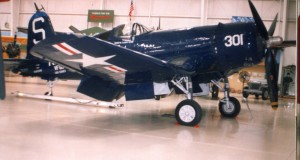
Bob Pond purchased this Vought FG-1D Corsair for his collection in 1983. It was built in 1957 and carries the markings of the carrier USS Essex.
Pond said his purchase in 1948 of that Cessna 180 was “the beginning of a lifetime of owning aircraft.” He’s amassed more than 22,000 flight hours.
“I have more type ratings than you can shake a stick at,” he said. Those ratings are commercial pilot, airplane single engine land and sea, airplane multi-engine land, rotorcraft helicopter, DC-3, CE-500, G-TBM, N-265, IA-Jet, L-1329, B-25, B-26 and B-17.
Although he’s had a few mishaps—some off-airport landings and a couple of engine failures—he says he’s been lucky.
“These things happen if you fly enough 60-year-old airplanes,” Pond said. “But I’ve never so much as gotten a bruise in an airplane.”
In 1970, a chance encounter led Pond to buy two vintage aircraft.
“I ran into a Northwest Airlines pilot who had rebuilt a P-40 Warhawk and P-51 Mustang,” Pond recalled. “He was retiring and wanted to work out a deal to sell them. I told him I would pay his price, but I wanted terms that were very liberal. I bought the planes, and he checked me out in them, but he also continued to fly them himself. The two of us would travel the country, go to air shows and have a lot of fun.”
Flying across the Pond
Pond’s aviation adventures include flying in the Duxford Air Show. He gained the opportunity through Englishman Stephen Grey, with whom Pond had a B-25 partnership. Grey keeps the Fighter Collection, his collection of warbirds, at Duxford Airfield in Cambridgeshire, Great Britain. Each year, Grey hosts an air show there; he flies his planes and invites other collectors to fly theirs.
When Grey would come to Minnesota, he’d fly Pond’s planes, and Pond would do the same at Duxford. With his wife, Jo, in the second seat, Pond flew Grey’s P-51 in an air show in 1984 celebrating the 40th anniversary of the Normandy invasion. They then flew back across the English Channel with a Spitfire flown by Grey and another P-51 flown by Steve Hinton, landing at Stansted, England.
The Pond Racer
One of Pond’s interests in aircraft and a primary motivation in collecting them is watching them fly. That led him to the Reno Air Races, which he attended every year for many years. He often sponsored aircraft before deciding to get further into the action.
“I love the Reno Air Races, but it seemed like once a year, there was a major destruction of one of these racing airplanes, most of which date back to World War II,” Pond said. “If it kept up, it seemed like it would be only a matter of years before there were very few of these airplanes left. I hated to see that happen, because there are just not enough around.”
Pond employed Burt Rutan to design and build the Model 158 Pond Racer, an all-graphite aircraft resembling a P-38 and powered by two Electramotive automobile engines capable of 1,000 hp each. He envisioned multiple contemporary racers, instead of warbirds, competing at Reno.
The Pond Racer participated at Reno in 1991 but dropped out due to mechanical failures. It came back the following year to finish second in the bronze race. In 1993, the aircraft crashed during time trials at Reno, killing its pilot, Rick Brickert.
“We had big ideas for the racer and had several wonderful opportunities in the races, but the crash brought the entire enterprise to a halt,” Pond said. “I have thought over the years—not for too long—that we have all the tools we need to build another racer. But at my age, I think it’s the right thing to let it pass on to others. I’m glad it’s inspired others to build aircraft designed specifically for racing.”
Palm Springs Air Museum
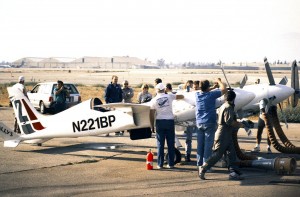
1986 National Champion Rick Brickert (standing with Bruce Boland behind cockpit) and the Planes of Fame crew review the Pond Racer following flight-testing east of Chino, Calif., prior to the 1991 Reno Air Races.
After living in Florida for years as winter residents, the Ponds decided they needed a change.
“When we realized we had to raise a grandchild, we decided that Florida wasn’t the place to be,” he said. “We went back to Minnesota, but it was just too cold. It was too cold during the 50 years I lived there the first time!”
The Ponds decided to relocate to Palm Springs, and they’ve never regretted that decision.
“We’ve never missed a day of praising this area and the people that live here,” he said. “It’s a living desert. We love everything, except the California taxes.”
Previously, Pond had established the Planes of Fame Air Museum at Flying Cloud Field in Eden Prairie, Minn.
“Jim Olzacki suggested the idea, since I had the P-51 and P-40,” he recalled. “We had a lot of visitors, but we didn’t get the kind of cooperation from the city and the county that would allow us the kind of flying we wanted to do.”
Pond closed the Eden Prairie museum and relocated his warbird collection to Palm Springs. He was the initial backer behind the Palm Springs Air Museum, which opened in 1996 at Palm Springs International Airport (PSP).
“I lent my collection immediately to the museum,” he said.
Pond is deeply committed to preserving WWII aircraft, honoring the sacrifices of his contemporaries and educating people about the war. But he’s not the only one; he said the museum has always been a “community organization.”
“People thought I owned the museum, but I never intended anything other than providing my airplanes,” he said.
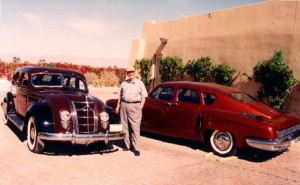
Much of Bob Pond’s exquisite collection is kept at the Palm Springs Air Museum, where the automobiles help set the pre-WWII scene. This 1935 Chrysler AirFlow and rare 1948 Tucker are examples of his collection.
The museum originally opened with two 20,000-foot hangars, a resource library, theater, gift shop and administrative offices totaling about 52,000 square feet of space. By 2000, the initial debt was paid down to $300,000. Thomas L. Phillips was a major sponsor toward a third hangar that opened in 2003. The 15,700-square-foot hangar was constructed to house Miss Angela, the museum’s B-17 Flying Fortress, which had been kept outside since it was acquired in November 1997.
The nonprofit museum became debt-free in 2004. Space had grown to about 67,000 square feet by 2005.
After serving as PSAM chairman for 12 years, Pond became chairman emeritus in January 2005. Phil Hixon, a founding director of the museum and a significant contributor early on, is now chairman of the board and CEO. Sharon Maguire, who began her career with the museum as marketing director in 1998, is president and museum director.
“We have the most wonderful group running the museum,” Pond said. “I get to sit back and enjoy the direction they’re taking, rather than being involved at 100 percent.”
Before turning over the reins to Hixon and Maguire, Pond arranged for the museum to purchase his remaining 14 planes that were under lease to the museum. Eventually, PSAM will own them in perpetuity.
Over the years, the museum collection has expanded to include many aircraft that have been completely restored. Leaning heavily towards Navy aircraft, Pond collected a number of Grumman airplanes, including a TBM Avenger, F7F-3 Tigercat and F4F Wildcat. He also acquired a Bell P-63 Kingcobra, a Supermarine Spitfire and two Douglas A-26C Invaders. The museum’s B-25T Mitchell has appeared in the films “Forever Young” and “Pearl Harbor.”
Although it’s not Navy, Pond loves his P-51D Mustang, Mighty Moose, whose former duty was with the Kentucky National Guard.
“Even though it’s an Air Force airplane, the P-51 is still the last word in WWII aircraft, as far as I’m concerned,” he said. “The P-38 is certainly a close second, but there’s nothing quite like flying that Mustang.”
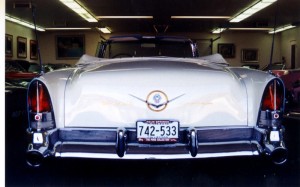
Bob Pond says he’s been an automobile collector for so long that he can’t even remember why he started—other than the fact that he loves to drive them. His collection includes this Packard Caribbean convertible.
He also has a soft spot for Miss Angela, which was used as a fire bomber during the 1960s and is one of 12 B-17s still flying. Pond restored the plane, gave it the marks of the 34th Bomber Group, 8th Air Force, and named it after his granddaughter.
“It’s almost as good as when it came out of the factory,” he said. “I spent a lot of money on getting it to be as good as or better than any B-17 flying today. I was trained in that aircraft by the very best people I could find. I flew it for about five years; now I have two other pilots who are just as experienced as I am and are better for the museum’s purposes.”
Maguire describes the museum as “very hands-on.” Aircraft aren’t roped off; visitors can get close to models and tours are available in some of the more popular planes, including the B-17, B-25 and C-47.
The museum, manned by more than 200 volunteers, sees more than 100,000 visitors a year. Admissions, memberships, gift shop sales and corporate events cover the annual operating budget of about $1.8 million. Donations and contributions to the museum go toward the museum’s education program, acquiring new aircraft and building exhibits. The museum has put a program in place that allows individual or group support of specific planes.
Several loans from the military, a few new acquisitions and visiting aircraft have augmented Pond’s collection in recent years. In 2005, an F-18 Hornet, on loan from the National Aviation Museum in Pensacola, Fla., joined an F-14 Tomcat, A-4 Skyhawk and A-6 Intruder in the museum’s Jet Park. The museum recently purchased a T-33 T-Bird and a PBY Catalina to add to its growing collection.
“I have a good relationship with the naval museum in Pensacola,” Pond said. “I was on the board of the National Museum of Naval Aviation. The people there worked hard to help us get started. They’ve been very beneficial in helping us with present-day aircraft that we can incorporate into our World War II collection. It helps us show fighters and other exotic aircraft of the present day that are the descendents of our 1940s aircraft.”
Original combat photography displays take visitors back in time, showing the aircraft in operational use during the war. Aviation art by gifted artist Stan Stokes helps emphasize the contributions of veterans like the Tuskegee Airmen. The museum uses aircraft and ship models to interpret the significance of air and sea battles.
“We did all of those models in the early days,” Pond explained. “When I was younger, I wanted a B-17. I never thought I’d be able to buy one, so I had a model built instead. Now we have both the models and the airplanes.”
The museum has drawn an extraordinary class of aviators, business leaders and celebrities to speak at events, including Walter Cronkite, Tom Brokaw, Enola Gay pilot Paul Tibbets, Bob Hoover and astronauts Wally Schirra and Sally Ride. The museum’s Youth Town Hall draws more than 2,400 local schoolchildren over a two-day period.
The museum has an outstanding educational program. Local schools benefit from the use of its extensive vintage library, including simulators. The museum is also working with the Library of Congress on a project to collect oral histories of WWII veterans and has compiled 600 so far. Additionally, the museum coordinates an after-school program for at-risk youth, offering credits towards graduation.
Fitting in another passion
Pond managed to incorporate his passion for automobiles into museum exhibits. He remembers when he started driving—at the age of 12.
“My father was a car nut,” he said. “He didn’t collect them, but he knew how to maintain and rebuild one. He helped me get started with automobiles at a very early age.”
Pond recalled that he sponsored a team at the Indianapolis 500 in 1968 and 1969, as a promotion for Advance Machine Company.
“We weren’t in it to win the race, although we were in the number-one spot for the first hour,” Pond said. “We developed enough horsepower to keep out in front and had enough fuel in our tank to drive longer than the rest of the field. We didn’t win the race, but it was a lot of fun.”
Pond has collected about 110 automobiles.
“I’ve been a collector for so long, I can’t even remember why I started with it, other than the fact that I love to drive them,” he said. “As time went on, I was able to make some investments and build a small collection that eventually turned into a medium-sized collection.”
His car collection includes a rare 1948 Tucker, 1935 Chrysler Airflow, seven Rolls Royce models dating back to the 1930s and several Lincoln convertibles, as well as a streak of red Ferraris. He also favors Aston Martins and has a whole range, from the DB4, a high-performance 1960 roadster, to his newest addition, a sleek AR1, a 2003 Roadster. Much of his exquisite collection is kept at the museum, where the automobiles help set the pre-WWII scene. If asked to name a favorite car, he has a standard answer.
“It’s the last car I drove on that particular day,” he says.
When Pond goes out to lunch, he often drives his new Aston Martin.
“Driving these automobiles, with their powerful engines, is an exhilarating experience,” he said. “It’s in my blood, I guess. The cars are truly beautiful, and it’s great to have other people enjoy them with me.”
Today
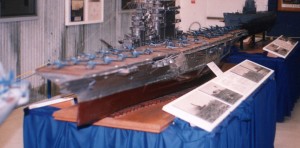
This model of the USS Lexington aircraft carrier, like all the models at the hands-on Palm Springs Air Museum, is uncovered and open to the public.
While in Florida in the 1960s, Pond met and married Jo Rose. Together, they’ve contributed a significant amount to the museum as well as to other charitable causes.
“This is what people do when they live in this country; they participate in the opportunities they have to share their knowledge and wealth with others,” Pond said. “Aviation gets some preference in the money we donate. Jo’s been as much an enthusiast in the aviation world as I have. She’s flown with me in warbirds over this whole country in many air shows.”
The University of Minnesota graduate contributes to his alma mater as well.
“I’m very pleased with the education I received,” he said. “The opportunities I had in the business world were really initiated at that university.”
In January 2002, Pond founded the Pond Family Chair for the Advancement and Teaching of Free Market Principles at the university’s Carlson School of Management. The Ponds have also been involved in their local community.
“Josie just goes and goes,” he said. “I’m slowing down a little bit, but she’s picking up the pace. She gets involved in a lot of community efforts.”
Pond still keeps a few “extra” planes for his personal use, including the first Piaggio Avanti off the line, an Italian turboprop that holds special meaning for Jo Pond, who is Italian.
“We have a backup Baron and a couple of other smaller airplanes that we play with around the area,” he said. “I still have a few Stearmans and some other planes.”
Pond says that these days, he prefers being a passenger.
“There’s a time to stop playing tennis, and there’s a time to stop playing with airplanes,” he said. “I’ve reached both. Now, I leave the flying to others and just enjoy being involved with other pilots and their planes.”
Pond says he’s been blessed to have many friends who have the same interest in aviation, such as aerobatic legend Bob Hoover.
“It’s great to be around him and be able to experience his extraordinary flying skills and enthusiasm for the sport,” he said.
He’s had the opportunity to meet many aviation greats, including Jimmy Doolittle and Chuck Yeager.
“I would’ve liked to have met and spent time with Howard Hughes,” he said.
As he takes more time for himself, Pond finds that he enjoys the Palm Springs Air Museum almost as much as any visitor. It remains a generous gift to future generations.
“With strong leadership, a great board and the support of the Coachella Valley, the museum is getting better and better,” Pond said. “It’s one of the top attractions in southern California. There’s no way to really get the sense of what a wonderful museum it is without visiting it in person.”











